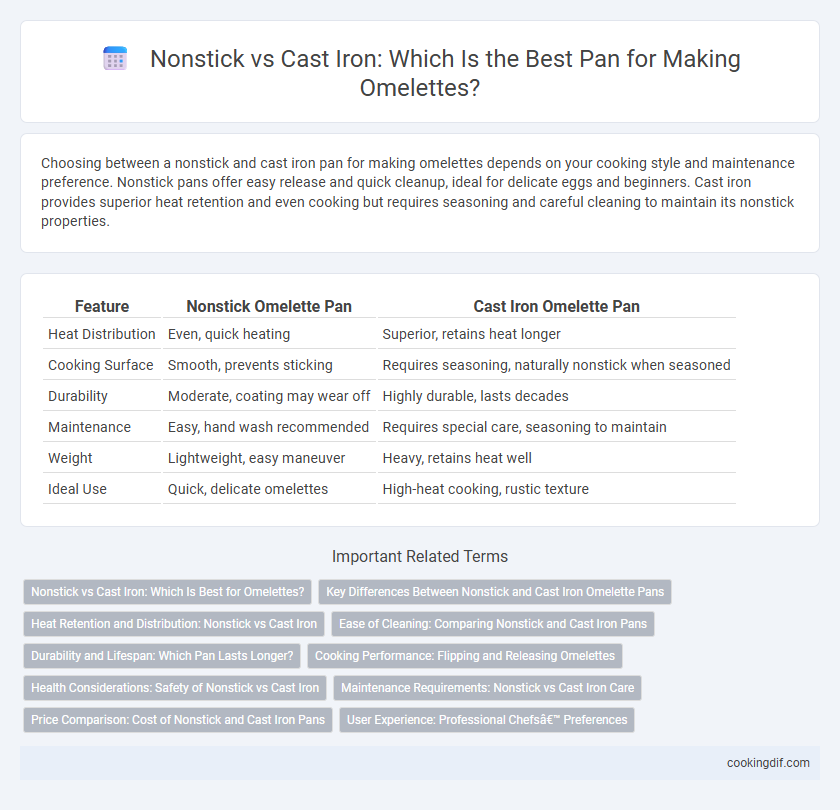Choosing between a nonstick and cast iron pan for making omelettes depends on your cooking style and maintenance preference. Nonstick pans offer easy release and quick cleanup, ideal for delicate eggs and beginners. Cast iron provides superior heat retention and even cooking but requires seasoning and careful cleaning to maintain its nonstick properties.
Table of Comparison
| Feature | Nonstick Omelette Pan | Cast Iron Omelette Pan |
|---|---|---|
| Heat Distribution | Even, quick heating | Superior, retains heat longer |
| Cooking Surface | Smooth, prevents sticking | Requires seasoning, naturally nonstick when seasoned |
| Durability | Moderate, coating may wear off | Highly durable, lasts decades |
| Maintenance | Easy, hand wash recommended | Requires special care, seasoning to maintain |
| Weight | Lightweight, easy maneuver | Heavy, retains heat well |
| Ideal Use | Quick, delicate omelettes | High-heat cooking, rustic texture |
Nonstick vs Cast Iron: Which Is Best for Omelettes?
Nonstick pans provide even heat distribution and effortless release, making them ideal for delicate omelettes requiring minimal oil. Cast iron offers superior heat retention and durability but demands seasoning and careful temperature control to prevent sticking. Choosing between nonstick and cast iron depends on ease of use versus longevity and flavor enhancement in omelette preparation.
Key Differences Between Nonstick and Cast Iron Omelette Pans
Nonstick omelette pans provide an easy release surface ideal for cooking delicate eggs, requiring minimal oil and simpler cleaning, while cast iron pans offer superior heat retention and even distribution for a well-cooked omelette with a crispy edge. Nonstick pans are lightweight and typically better for quick, low-heat cooking, whereas cast iron pans, though heavier and requiring seasoning, enhance flavor development and durability over time. The choice often depends on cooking style, maintenance preference, and the desired texture of the omelette.
Heat Retention and Distribution: Nonstick vs Cast Iron
Cast iron pans excel in heat retention and even heat distribution, allowing omelettes to cook uniformly and develop a consistent texture. Nonstick pans heat up quickly but may have uneven heat distribution, potentially causing hot spots that can lead to uneven cooking. For precise temperature control and longer cooking times, cast iron offers superior performance, while nonstick is better for quicker, lower-heat cooking.
Ease of Cleaning: Comparing Nonstick and Cast Iron Pans
Nonstick pans offer superior ease of cleaning for omelette preparation, as their smooth surfaces prevent eggs from sticking and require minimal scrubbing. Cast iron pans demand more maintenance, including seasoning and thorough drying to prevent rust, which can complicate cleaning after cooking delicate omelettes. While nonstick coatings degrade over time, their convenience in cleanup often outweighs the durability and heat retention benefits of cast iron for everyday omelette enthusiasts.
Durability and Lifespan: Which Pan Lasts Longer?
Cast iron pans offer exceptional durability and can last a lifetime with proper care, often improving with use due to their seasoning layer. Nonstick pans typically have a shorter lifespan, usually around 3 to 5 years, as their coatings can degrade or peel with frequent use and high heat. Choosing cast iron ensures long-term investment, whereas nonstick pans provide convenience but require more frequent replacement.
Cooking Performance: Flipping and Releasing Omelettes
Nonstick pans excel in releasing omelettes effortlessly, preventing sticking and enabling smooth flipping due to their slick surface coated with PTFE or ceramic. Cast iron pans, while requiring seasoning for optimal nonstick properties, provide superior heat retention and even cooking that enhances omelette texture but may demand more skill to flip without tearing. The choice between these pans impacts cooking performance: nonstick favoring ease and precision, cast iron offering durability and superior heat management for ideal omelette results.
Health Considerations: Safety of Nonstick vs Cast Iron
Nonstick pans, often coated with polytetrafluoroethylene (PTFE), offer a convenient cooking surface but can release harmful fumes if overheated above 500degF, raising health concerns. Cast iron pans provide a natural, chemical-free alternative that may leach beneficial iron into food, supporting dietary iron intake without the risk of synthetic coating degradation. Choosing cast iron reduces exposure to synthetic chemicals and promotes better long-term health safety during omelette preparation.
Maintenance Requirements: Nonstick vs Cast Iron Care
Nonstick omelette pans require minimal maintenance, typically needing gentle hand washing and avoiding abrasive cleaners to preserve the coating. Cast iron skillets demand regular seasoning to maintain their nonstick properties and prevent rust, along with thorough drying after each use. Proper care extends the lifespan of both types but cast iron's maintenance is more labor-intensive compared to nonstick.
Price Comparison: Cost of Nonstick and Cast Iron Pans
Nonstick omelette pans generally cost between $20 and $50, offering an affordable option for budget-conscious cooks. Cast iron pans range from $30 to over $100, with higher-end models providing durability and heat retention but requiring more maintenance. Considering price alone, nonstick pans present a lower upfront investment, while cast iron offers long-term value due to its longevity.
User Experience: Professional Chefs’ Preferences
Professional chefs favor cast iron pans for omelettes due to their superior heat retention and even cooking surface, which allows for precise control in achieving the perfect texture. Nonstick pans offer convenience with easy release and minimal oil use, making them popular for quick, hassle-free cooking. However, many experts prefer cast iron's durability and ability to develop a natural seasoning that enhances flavor over time.
Nonstick vs cast iron for omelette pan Infographic

 cookingdif.com
cookingdif.com